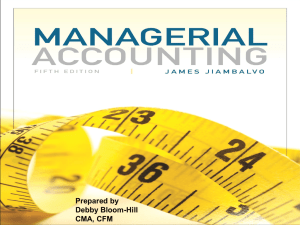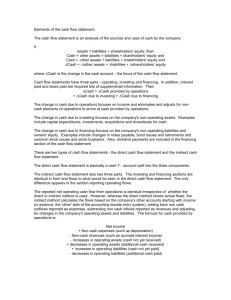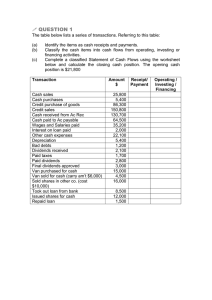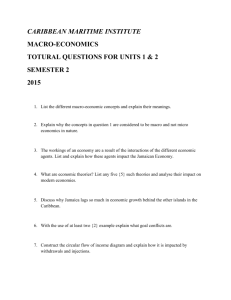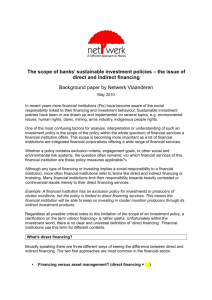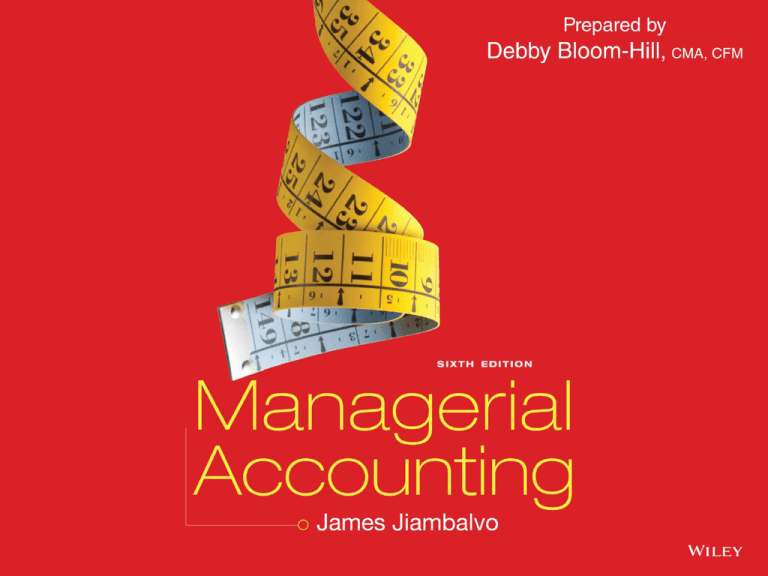
CHAPTER 13
Statement of Cash Flows
Slide 13-2
Need for a Statement of Cash Flows
Stakeholders want to know how a company
generates and spends cash
Can the company
Generate enough cash to pay its wages and
bills, including debt payments
Generate cash in order to earn a reasonable
return and pay dividends
Generate enough cash to avoid bankruptcy
Slide 13-3
Learning objective 1: Explain the need for the statement of
cash flows and identify the three types of business
activities presented in a statement of cash flows.
Need for a Statement of Cash Flows
Cash flow is not the same as net income
Under GAAP, income is calculated using the
accrual method
The income statement does little to inform
managers and other company stakeholders
of the sources and uses of cash
Slide 13-4
Learning objective 1: Explain the need for the statement of
cash flows and identify the three types of business
activities presented in a statement of cash flows.
Need for a Statement of Cash Flows
For the purposes of the cash flow statement,
cash includes both cash and cash
equivalents
Cash equivalents are short term investments
that can be readily converted into cash
Examples include 90 day US Treasury Bills
and money market funds
Slide 13-5
Learning objective 1: Explain the need for the statement of
cash flows and identify the three types of business
activities presented in a statement of cash flows.
Types of Business Activities
Operating activities
Cash flows related to production and delivery
of goods and services
Reflect the day to day profit oriented activities
of a business
Principal cash inflows are cash sales and
collection of accounts receivable
Major sources of cash outflows include
payments to suppliers, employees and taxing
authorities
Slide 13-6
Learning objective 1: Explain the need for the statement of
cash flows and identify the three types of business
activities presented in a statement of cash flows.
Examples of Operating Activities
Slide 13-7
Learning objective 1: Explain the need for the statement of
cash flows and identify the three types of business
activities presented in a statement of cash flows.
Types of Business Activities
Investing activities
Cash flows related to buying and selling of
long-term assets
Examples include collections from long term
loans, collections from the sale of equipment
no longer in use, payments to buy securities of
other companies, buying a building and buying
a business
Slide 13-8
Learning objective 1: Explain the need for the statement of
cash flows and identify the three types of business
activities presented in a statement of cash flows.
Examples of Investing Activities
Slide 13-9
Learning objective 1: Explain the need for the statement of
cash flows and identify the three types of business
activities presented in a statement of cash flows.
Types of Business Activities
Financing activities
Cash inflows related to issuing stock and
issuing long-term debt
Cash outflows related to repurchasing
stock, paying off loans and making
dividend payments
Slide 13-10
Learning objective 1: Explain the need for the statement of
cash flows and identify the three types of business
activities presented in a statement of cash flows.
Examples of Financing Activities
Slide 13-11
Learning objective 1: Explain the need for the statement of
cash flows and identify the three types of business
activities presented in a statement of cash flows.
Which of the following would be a cash outflow
from operating activities?
a.
b.
c.
d.
Acquisition of operating equipment
Retirement of bonds
Collection of accounts receivable
Payments to suppliers for raw materials
Answer: d
Payments to suppliers for raw materials
Slide 13-12
Learning objective 1: Explain the need for the statement of
cash flows and identify the three types of business
activities presented in a statement of cash flows.
Which of the following would be a cash outflow
from investing activities?
a.
b.
c.
d.
Payments to suppliers
Payments to employees
Purchase of land
Payment of dividends
Answer: c
Purchase of land
Slide 13-13
Learning objective 1: Explain the need for the statement of
cash flows and identify the three types of business
activities presented in a statement of cash flows.
Which of the following would be a cash outflow
from financing activities?
a.
b.
c.
d.
Payment of dividends
Payments to taxing authorities
Purchase of land
Cash sales
Answer: a
Payment of dividends
Slide 13-14
Learning objective 1: Explain the need for the statement of
cash flows and identify the three types of business
activities presented in a statement of cash flows.
Statement of Cash Flows General
Format
Slide 13-15
Learning objective 2: Prepare a statement of cash
flows using the direct method.
Preparing the Statement of Cash Flows
Two acceptable methods
Direct method
Like an income statement prepared using the
cash basis
Indirect method
Reconciles net income to cash flow from
operations
Preferable under GAAP
Most used in financial statements
Slide 13-16
Learning objective 2: Prepare a statement of cash
flows using the direct method.
Preparing the Statement of Cash Flows
Cash flows from operating activities
Cash collected on sale of merchandise
Cash received (paid) related to interest
income (expense)
Cash received related to dividend income
Cash paid to purchase merchandise
Cash paid for general and administrative
expenses
Cash paid for income taxes
Slide 13-17
Learning objective 2: Prepare a statement of cash
flows using the direct method.
Preparing the Statement of Cash Flows
Cash flows from investing activities
Cash received on the sale of a machine no
longer in use
Cash paid to buy a machine
Cash paid to buy a building
Cash received from selling a building
Cash paid to buy a business
Slide 13-18
Learning objective 2: Prepare a statement of cash
flows using the direct method.
Preparing the Statement of Cash Flows
Cash flows from financing activities
Slide 13-19
Cash received from selling bonds
Cash received from using a line of credit
Cash received from issuing common stock
Cash paid to retire long term debt
Cash dividends paid
Learning objective 2: Prepare a statement of cash
flows using the direct method.
Preparing the Statement of Cash Flows
Direct method
Lists specific cash inflows and outflows from
operating activities
Similar to cash-basis income statement within
the operating activities section
FASB requires separate schedule to reconcile
cash flows from operating activities and net
income
Slide 13-20
Learning objective 2: Prepare a statement of cash
flows using the direct method.
Cash Flows from Operating Activities
(Direct Method)
To determine cash flows using the direct
method
Analyze all balance sheet accounts, other
than cash, to determine how their changes
were affected by cash flows
This analysis will involve information from the
income statement
Slide 13-21
Learning objective 2: Prepare a statement of cash
flows using the direct method.
Cash Flows from Operating Activities
(Direct Method)
Current asset and current liability accounts
The first account is cash received from
customers
Solving the following equation yields cash
receipts of $10,004,825
Beginning balance receivables
Plus sales
Less cash collected
$879,053
10,548,640
?
Equals ending balance receivables
$1,422,868
Slide 13-22
Learning objective 2: Prepare a statement of cash
flows using the direct method.
Cash Flows from Operating Activities
(Direct Method)
Current asset and current liability accounts
The next item is cost of merchandise sold
The following formula yields purchases of
$8,286,993
Beginning inventory
Plus purchases
Less cost of goods sold
Equals ending balance inventory
Slide 13-23
$988,935
?
7,911,480
$1,364,448
Learning objective 2: Prepare a statement of cash
flows using the direct method.
Cash Flows from Operating Activities
(Direct Method)
Current asset and current liability accounts
Purchases of $8,286,993 are used in the next
calculation, which solves for cash payments for
purchases of inventory of $8,202,703
Beginning balance accounts payable
$575,000
Plus purchases
Less cash paid for inventory purchases
Equals ending balance accounts payable
8,286,993
?
$659,290
Slide 13-24
Learning objective 2: Prepare a statement of cash
flows using the direct method.
Cash Flows from Operating Activities
(Direct Method)
Analyze other current asset and liability
accounts
Use prepaid insurance and insurance
expense to solve for cash payments for
insurance
Use accrued wages and salaries and wages
and salaries expense to solve for cash
payments for wages and salaries
Use income taxes payable and income tax
expense to solve for cash payments for
income taxes
Slide 13-25
Learning objective 2: Prepare a statement of cash
flows using the direct method.
Cash Flows from Operating Activities
(Direct Method)
Long term asset accounts
Use accumulated depreciation, depreciation
expense, book value of equipment sold, and
loss on sale to solve for
Cash proceeds related to sale of equipment,
and
Cash paid for purchases of equipment
Slide 13-26
Learning objective 2: Prepare a statement of cash
flows using the direct method.
Cash Flows from Operating Activities
(Direct Method)
Long term liabilities and stockholders’ equity
Cash paid to reduce debt (or cash proceeds
from borrowing) is the difference between the
beginning and ending balance of long term
debt
Use beginning and ending retained earnings
plus net income to solve for cash payments
for dividends
Slide 13-27
Learning objective 2: Prepare a statement of cash
flows using the direct method.
RS Inc. has the following information:
Taxes payable 12/31/2016: $171,000
Income tax expense 2017: $585,000
Taxes payable 12/31/2017: $150,000
Calculate cash paid for taxes in 2017
Answer:
$171,000 + ? - $150,000 = $585,000
? = 564,000
Slide 13-28
Learning objective 2: Prepare a statement of cash
flows using the direct method.
Preparing the Statement of Cash Flows
(Indirect Method)
The indirect method is much more common
The two methods differ only in terms of the
presentation of cash flows related to operating
activities
There are no differences for inventing activities
and financing activities
Learning objective 3: Prepare a statement of cash
flows using the direct method and interpret information
in the statement of cash flows.
Preparing the Statement of Cash Flows
(Indirect Method)
5 step approach to calculate cash flows from
operating activities – indirect
1. Start with net income
2. Add non-cash expenses such as
depreciation and amortization
3. Subtract gains and add back losses
4. Subtract (add) increases (decreases) in
current assets other than cash
5. Add (subtract) increases (decreases) in
current liabilities
Learning objective 3: Prepare a statement of cash
flows using the direct method and interpret information
in the statement of cash flows.
Preparing the Statement of Cash Flows
(Indirect Method)
The operating activities section is a
reconciliation of net income to cash flows
from operating activities
Current assets
Increases in current assets indicate we must
reduce income to convert to cash basis
Decreases indicate we must increase income
to convert to cash basis
Learning objective 3: Prepare a statement of cash
flows using the direct method and interpret information
in the statement of cash flows.
Preparing the Statement of Cash Flows
(Indirect Method)
Current liabilities
Increases in current liabilities indicate we
must increase income to convert to cash
basis
Decreases in current liabilities indicate we
must reduce income to convert to cash basis
Learning objective 3: Prepare a statement of cash
flows using the direct method and interpret information
in the statement of cash flows.
Indirect Method part 1
Slide 13-33
Learning objective 3: Prepare a statement of cash
flows using the direct method and interpret information
in the statement of cash flows.
Indirect Method part 2
Slide 13-34
Learning objective 3: Prepare a statement of cash
flows using the direct method and interpret information
in the statement of cash flows.
Using the indirect method, changes in current assets
other than cash and current liabilities are used to
adjust net income to determine:
a. Income from operations
b. Net cash from investing activities
c. Net cash provided by operating activities
d. None of the above
Answer: c
Net cash provided by operating activities
Slide 13-35
Learning objective 3: Prepare a statement of cash
flows using the direct method and interpret information
in the statement of cash flows.
Interpreting the Statement of Cash
Flows
In general, the most important part is the cash
flows from operating activities
Unless a company is able to generate cash
from its core operations, it is unlikely to
succeed
If cash flows in this section are low, this
implies that a company must offset them by
changes in investing and financing decisions
Slide 13-36
Learning objective 3: Prepare a statement of cash
flows using the direct method and interpret information
in the statement of cash flows.
Statement of Cash Flows
Slide 13-37
Learning objective 3: Prepare a statement of cash
flows using the direct method and interpret information
in the statement of cash flows.
Copyright
© 2016 John Wiley & Sons, Inc. All rights reserved.
Reproduction or translation of this work beyond that permitted in
Section 117 of the 1976 United States Copyright Act without the
express written permission of the copyright owner is unlawful.
Request for further information should be addressed to the
Permissions Department, John Wiley & Sons, Inc. The
purchaser may make back-up copies for his/her own use only
and not for distribution or resale. The Publisher assumes no
responsibility for errors, omissions, or damages, caused by the
use of these programs or from the use of the information
contained herein.
Slide 13-38

